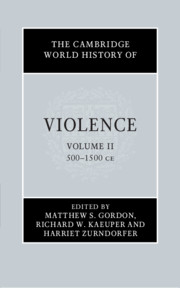Book contents
- The Cambridge World History of Violence
- The Cambridge History of Violence
- The Cambridge World History of Violence
- Copyright page
- Contents
- Figures and Table
- Contributors to Volume II
- Introduction to Volume II
- Part I Beyond Warfare: Armies, Tribes and Lords
- 1 Violence in Inner Asian History
- 2 Conspirators in Violence
- 3 Armies, Lords and Subjects in Medieval Iran
- 4 Armies and Bands in Medieval Europe
- 5 Viking Violence
- Part II The Violence of Governments and Rulers
- Part III Social, Interpersonal and Collective Violence
- Part IV Religious, Sacred and Ritualised Violence
- Part V Depictions of Violence
- Index
- References
2 - Conspirators in Violence
Disorder, the Imperial State and its Armies in Medieval China
from Part I - Beyond Warfare: Armies, Tribes and Lords
Published online by Cambridge University Press: 13 March 2020
- The Cambridge World History of Violence
- The Cambridge History of Violence
- The Cambridge World History of Violence
- Copyright page
- Contents
- Figures and Table
- Contributors to Volume II
- Introduction to Volume II
- Part I Beyond Warfare: Armies, Tribes and Lords
- 1 Violence in Inner Asian History
- 2 Conspirators in Violence
- 3 Armies, Lords and Subjects in Medieval Iran
- 4 Armies and Bands in Medieval Europe
- 5 Viking Violence
- Part II The Violence of Governments and Rulers
- Part III Social, Interpersonal and Collective Violence
- Part IV Religious, Sacred and Ritualised Violence
- Part V Depictions of Violence
- Index
- References
Summary
This essay consists principally of a tandem historical dissection of the two most notoriously consequential uprisings in the history of China’s late medieval age. These cataclysmic domestic revolts were those led by the rebels Huang Chao (d. 884) at the close of the ninth century and Fang La (d. 1121) at the beginning of the twelfth, respectively. The analysis herein seeks to reveal how integrally and thoroughly an ongoing culture of insurgency belied what has emerged as an anachronistic mythology of imperially sanctioned order. Spanning throughout these centuries as it did, we must indeed regard internal disorder as having been a hallmark of Chinese life during that time. Moreover, with shockingly regularized frequency and brutality, the resolution of disorder pitted the weaponized citizenry of the empire against the very armies that were nominally intended to protect it. No less enigmatic or ironic is the revelation that these armies – especially through the abuses that attended their increasing reliance on conscription in transitioning from elite into professionalized forces – played just as pivotal a role in fomenting of the very resistance waged against them as they did in being chiefly responsible for its suppression.
- Type
- Chapter
- Information
- The Cambridge World History of Violence , pp. 38 - 57Publisher: Cambridge University PressPrint publication year: 2020

